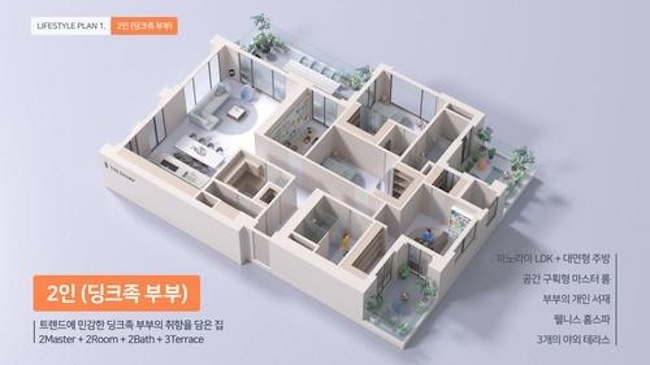
Posco E&C, a prominent South Korean builder, unveiled 20 new apartment designs on May 27 at an event titled “Tomorrow’s Living Spaces: Strategies and Floor Plans.” (Image courtesy of POSCO E&C)
SEOUL, Sept. 3 (Korea Bizwire) — As South Korea grapples with shifting demographics and evolving living patterns, major construction companies are introducing innovative apartment designs that allow residents to easily modify their living spaces.
On August 31, industry leaders showcased new floor plans that break from traditional layouts, offering adaptable structures that can be customized to accommodate various family sizes and lifestyles.
Posco E&C, a prominent South Korean builder, unveiled 20 new apartment designs on May 27 at an event titled “Tomorrow’s Living Spaces: Strategies and Floor Plans.” The company has dubbed its new concept Flexiform, emphasizing the flexibility of these living spaces.
The Flexiform designs cater to a diverse range of household compositions, from traditional four-person families to childless couples, active senior couples, three-person families with only children, multi-generational households, and families with adult children still living at home.
For instance, one design for dual-income couples without children features separate sleeping areas within the master bedroom, with an optional door between them to minimize sleep disruption for partners with different schedules.
Another layout, tailored for elderly couples, includes a spacious living-dining-kitchen area to accommodate family gatherings, while also providing a smaller dining nook for the couple’s daily use.
To achieve this adaptability, Posco E&C has employed construction techniques that minimize load-bearing walls within the apartment by positioning support columns along the perimeter.

Posco E&C, a prominent South Korean builder, unveiled 20 new apartment designs on May 27 at an event titled “Tomorrow’s Living Spaces: Strategies and Floor Plans.” (Image courtesy of POSCO E&C)
The company has even designed plumbing systems that allow for the relocation of bathrooms and other water-dependent areas.
“The decline in the birth rate is changing family structures, leading to rapid shifts in housing needs and consumer preferences,” said Jeong Hee-min, head of Posco E&C’s architecture division.
“We focused on spatial flexibility to address this growing diversity in living arrangements.”
Samsung C&T, another major player in the construction industry, introduced its own flexible housing model called Next Home in August of last year. The core of this concept lies in the company’s proprietary “Next Rahmen structure” and “In-Fill system.”
The Next Rahmen structure is a column-and-beam system that places support columns on the exterior, creating an open interior space. The In-Fill system utilizes modular components that allow residents to configure their living spaces like building with Lego blocks.
The system includes raised flooring with underfloor utilities and movable, modular wall units. Even furniture is designed to be mobile and multifunctional, with some pieces capable of serving as room dividers.
With these innovations, residents can easily modify their living spaces over time, such as combining rooms or creating a new bedroom when a child is born.
Some industry observers suggest that these new designs are not only a response to demographic shifts but also a strategic move to secure urban renewal projects.
“It’s a calculated approach with redevelopment and reconstruction projects in mind,” said an executive from a major construction firm who spoke on condition of anonymity.
“To win over property owners in competitive bids, companies need to continually introduce novel floor plans.”
Another industry insider noted that these adaptable designs are aimed at creating “century homes” that can be easily modified by residents and renovated in the future, reducing the need for complete reconstruction.
Lina Jang (linajang@koreabizwire.com)






